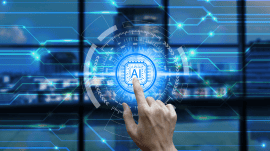
What is 4IR?

This article will define Industrial Revolution 4.0, explaining how it is connected to digital transformation and business intelligence. It will examine technology’s rapidly evolving role in an increasingly remote, data-driven, and cloud-based world.
Why Did 4IR Happen?
While the last IR was characterized by the development and widespread use of electricity, the fourth IR is characterized by the rapid growth of information technology, the proliferation of the Internet with sudden, dramatic advancements in response to outside changes, like a pandemic. As a result, organizations rely on digital technology more than ever before. Since the pandemic, many realized they lacked the necessary infrastructure, security, and cloud technology to support digital innovation.
Eleni Papadonikolaki of University College London writes, “Complex projects and megaprojects are increasingly shaped by new enabling technologies and new demands from businesses… Success will be to empower the people who deliver megaprojects such that they can deliver the value to people, process, and digital components.”
She illustrates how businesses ignore innovation, collaboration, and technology at their peril. Only tech-forward, transformational organizations will survive. Perhaps surprisingly, the very human components of collaboration, communication, and co-creation are also essential to digital transformation.
Digital Transformation, Real-Time Data, and Digital Twins
What is known as digital transformation is not something we could have predicted even twenty years ago. Coupled with the birth of the Internet as we know it today, the abundance of data available online proved to be a complete and utter game-changer.
We used to share data instantly with team members via email or phone. After the pandemic hit, however, Zoom meetings became the new norm. With the onset of lockdowns across the country and worldwide, it quickly became evident that companies needed to pivot—and to do so soon—if they wanted to stay in the game.
Pushing the boundaries further, companies not already in the cloud when the pandemic hit found themselves dead in the water with on-prem systems unable to reach a new remote workforce. In contrast, innovative organizations were able to respond swiftly to the pandemic through the cloud, enabling collaboration in real-time across distance and time zones in a way that would have been next to impossible last century. The ongoing pandemic magnifies remote work culture characteristics that are quickly becoming ubiquitous:
- Zoom calls & remote team meetings
- Cloud-based project management
- Integration of multiple project applications & software programs
Clint Boulton of CIO defines digital transformation as “A foundational change in how an organization delivers value to its customers,” listing five steps companies can follow to affect change:
- Align business goals with objectives.
- Encourage IT & business to co-create.
- Select strategic partners.
- (Re)Design products & business around customer outcomes.
- Focus employee (re)training on digital.
McKinsey echoes this sentiment in a recent survey: they confirmed the need to put technology front and center to survive 4IR. Because of the mandatory nature of social distancing and remote culture, many realized they no longer had a choice in the matter due to the ongoing pandemic. If they didn’t adapt to the ‘new normal,’ their business would fail. These organizational disruptions and reorientations are essential to thriving in this new digital age.
For example, to create a highly effective digital twin, you need to regularly update digital roadmaps and keep them flexible, ensuring digital teams are adequately staffed and optimize ROI. It’s also essential to periodically upgrade related functions and leverage digital solutions throughout physical lifecycles.
But don’t take our word for it. A recent study soon to be published in Measuring Business Excellence demonstrated the business impact of digital twin technology—still considered a technical solution on the cutting edge of supply chain management. The researchers found that “Implementation of the digital twin (DT) was calculated to provide a significant supply chain performance improvement” that, along with higher cognition tools, constituted the primary financial return over time, with significant topline improvement.
Digital twin technology is only one example of 4IR changing the landscape. The investment in new, real-time technology enabling the creation of digital twins and other sweeping digital technology advancements is worth it. But how do you get there?
The Need for Cloud Options
Project and portfolio management in the cloud is one of the essential aspects of 4IR that is here to stay. Understanding the different cloud options available to you is critical to managing important projects remotely and in real-time as part of project controls.
Managing Director Dr. Asif Sharif recently addressed this need to center real-time cloud technology, data integration, and a holistic view of data in the cloud on Hugh Seaton’s podcast, Constructed Futures:
Seaton: We’re getting more used to cloud-based transactions. People [will] have very different expectations and…be more comfortable with things at work than they may have been pre-pandemic. Do you think that’s a big driver?
Sharif: I do think it is a big driver. And I think it’s something that’s structurally going to change our sector, [which] is a seismic shift… A lot of people have referred to it as Industrial Revolution 4.0. We’ve just had the catalyst that’s brought it into very specific focus for us as construction practitioners. The pandemic has forced us to start thinking about it.
It also highlights some risks. Over the last three years, we’ve doubled the amount of data we’re generating from the tools we’re using in the construction space, right? That’s quite a significant change. And that trend will absolutely increase over time…
We’re thinking about the integration of tools. We’re looking at how we can look at 345 dimensions of information, not just a visual view: but we want a cost view, a time view, a visual view, a geospatial view of data, right? So, we’re now starting to think about a more holistic view of how we’re looking at project information.
Here, Sharif highlights the importance of not only tool integration but also a comprehensive approach.
Integration needs to be accompanied by usability and accessibility.
Cloud Project Controls & Accessibility
Cloud-based project controls make accessibility possible because they are available online whenever needed, from wherever team members are. Ease of access, both physical and in real-time, is critical to coming in at or under budget and schedule. With more and more teams dispersed over wide-reaching geographic areas, the importance of real-time updates cannot be overstated.
It’s critical to ensure your data is protected, your software licenses are legally compliant, and you have quick access to real-time data. But it also helps to have a team of experts backing you up.
Having the ability to turn to an entire team of cloud experts who can manage the things you don’t need or want to think about is essential.
It’s vital to your bottom line to save your internal IT team’s energy for focusing on onsite hardware or networking setbacks. It’s also crucial because of licensing and compliance issues—which you’ll no longer need to think about if someone is managing your program applications in the cloud for you. Lastly, all company users need to have the ability to access programs according to the needs of executives, department heads, project goals, and objectives.
Since user provisioning in the cloud is tightly controlled, you won’t need to worry as much about data leakage or security protocols being violated, either. And the people utilizing applications like Oracle Primavera don’t always necessarily need to know how they work to effectively use them—depending on their role in the project.
Take TikTok LIVE broadcasts: kids and teenagers utilize this technology regularly to deliver streaming broadcasts to their followers in real-time. However, that doesn’t mean they understand the technology. All they know is that live-streaming technology gives them the capacity to reach millions of followers, enabling them to become the next generation of TikTok stars with ease.
Business Intelligence: What’s Ahead?
That’s why a platform-as-a-service (PaaS)-based system is so helpful in making sure you have access to the correct data at any given time. Revolutionary, transformative project controls are closer than you think. With LoadSpring Cloud Platform, you can find out more about what you’re missing.
Efficient data analysis begins with usable data. But the analytics component is lost without a tangible, human element to manage it intelligently. You must sustain project controls for a significant amount of time to utilize data effectively. Enter LoadSpring ProjectNTEL, your journey to data trust that begins with accumulating clean, usable data via LoadSpring Cloud Platform and ends with more fully realized analysis and integration.
With the help of the best tools and the most knowledgeable team of experts, we can help make all your 4IR digital transformation dreams come true. Contact us.








